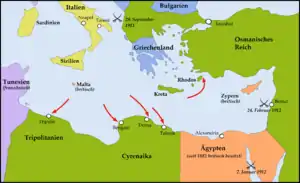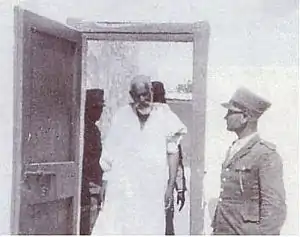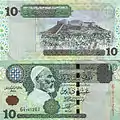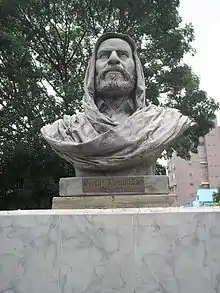Omar al-Mukhtar
ʿOmar al-Mukhṭār Muḥammad bin Farḥāṭ al-Manifī (Arabic: عُمَر الْمُخْتَار مُحَمَّد بِن فَرْحَات الْمَنِفِي ; 20 August 1858 – 16 September 1931), called The Lion of the Desert, known among the colonial Italians as Matari of the Mnifa,[4] was the leader of native resistance in Cyrenaica (currently Eastern Libya) under the Senussids, against the Italian colonization of Libya. A teacher-turned-general, Omar was also a prominent figure of the Senussi movement, and he is considered the national hero of Libya and a symbol of resistance in the Arab and Islamic worlds. Beginning in 1911, he organised and, for nearly twenty years, led the Libyan resistance movement against the Italian colonial empire during the Pacification of Libya. After many attempts, the Italian Armed Forces managed to capture Al-Mukhtar near Solonta and hanged him in 1931.
Omar al-Mukhtar عُمَر الْمُخْتَار | |
|---|---|
 Assad El-Sahra (أسد الصحراء) or "Lion of the Desert" | |
| Ruler of Zawiyat Ayn Kalk | |
| In office 1896–1902 | |
| Succeeded by | Post abolished |
| Ruler of Zawiyat Luqsur | |
| In office 1902–1911[1] | |
| Succeeded by | Post abolished |
| Leader of Senussi Tribal Military | |
| In office 24 April 1923 – 16 September 1931[2] | |
| Preceded by | Idris Al-Senussi |
| Succeeded by | Yusuf Borahil |
| Personal details | |
| Born | 20 August 1858 Zawiyat Algsour, Nahiyah Tobruk, Kaza Derna, Sanjak Benghazi, Eyalet-i Trâblus Gârb, Ottoman Empire |
| Died | 16 September 1931 (aged 73) Benghazi, Italian Cyrenaica |
| Resting place | Suluq, Libya |
| Nationality | Libyan |
| Parents | Al-Mukhtar ibn Muhammad (father) Aisha Bint Muharib (mother) |
| Occupation | Ruler of Senussi Zawiyas |
| Known for | Leading Arab and native Berber resistance to Italian colonization of Libya |
| Religion | Islam (Sunni) Denomination: Maliki[3] |
| Signature |  |
| Military service | |
| Nickname(s) | Shaykh ash-Shuhadā’ شَيخ الشُّهَدَاء, Sheikh of the Martyrs |
| Allegiance | |
| Branch/service | |
| Years of service | |
| Battles/wars | Italo-Turkish War Senussi campaign Senussid-Italian War |
Early life
| Senussi dynasty السنوسية (in Arabic) | |
|---|---|
| Country | Cyrenaica Tripolitania Fezzan |
| Founder | Muhammad ibn Ali as-Senussi |
| Current head | Mohammed El Senussi; Idris bin Abdullah al-Senussi (rival claimant) |
| Final ruler | Idris of Libya |
| Titles | |
| Dissolution | 1969 |
| Deposition | 1969: Overthrown by Muammar Gaddafi's 1 September Coup d'état |
'Omar Al-Mukhtar was born in 1858 to a family in the town of Zanzur near Tobruk, in the region of Ottoman Cyrenaica, belonging to the Senussi (who were seen as Libyan Ashrafs) Arab clan just like Emir or King Idris es Senussi,[5][6] eventually becoming chief or leader of the clan. As a child Omar lost his father early on, and spent his youth in poverty, he was adopted by a great sheikh, and was friends with the nephew of Hussein Ghariani, Sharif al Geriani. His uncle was a political-religious leader in Cyrenaica, and received his early education at the local mosque, before continuing his studying for eight years at the Senussi university in Jaghbub,[7] the holy city of the Senussi Tariqa, He became a popular expert on the Quran and an imam, joining the confraternity of the Senussi, he also came to be well informed of the social structure of his society, as he was chosen to settle intertribal disputes.
Mukhtar developed a strong relationship with the Senussid Movement during his years in Jaghbub, in 1895, Al-Mahdi Senoussi traveled with him south to Kufra, and on another occasion further south to Karo in Chad, where he was appointed as sheikh of Zawiyat Ayn Kalk, when the French Empire encroached on Chad in 1899 he was sent among other Senussites to help defend Chad from the French, as the Senussi considered their expansion dangerous due to their missionary activities in Central and West Africa. In 1902, Omar was recalled north after the death of Al-Mahdi, the new Senussi leader Ahmed Sharif as-Senussi appointed him as Sheikh of the troubled Zawiyat Laqsur in Northern Cyrenaica.
Italian invasion

In October 1911, during the Italo-Turkish War, the Regia Marina (Italian Royal Navy) under the command of Admiral Luigi Faravelli reached the shores of Libya, then a territory subject to Ottoman control. The admiral demanded that the Ottoman administration and garrison surrender their territory to the Italians or incur the immediate destruction of the city of Tripoli and Benghazi. The Ottomans and their Libyan allies withdrew to the countryside instead of surrendering, and the Italians bombarded the cities for three days, and then proclaimed the Tripolitanians to be 'committed and strongly bound to Italy'.[8] This marked the beginning of a series of battles between the Italian colonial forces and the Libyan armed opposition in Cyrenaica.[9]
Guerrilla warfare

A teacher of the Qur'an by profession, Mukhtar was also skilled in the strategies and tactics of desert warfare. He knew local geography well and used that knowledge to advantage in battles against the Italians, who were unaccustomed to desert warfare. Mukhtar repeatedly led his small, highly alert groups in successful attacks against the Italians, after which they would fade back into the desert terrain. Mukhtar’s men skilfully attacked outposts, ambushed troops, and cut lines of supply and communication. The Regio Esercito (Italian Royal Army) was left astonished and embarrassed by his guerrilla tactics.[10]
In the mountainous region of Jebel Akhdar ("Green Mountain") in 1924, Italian governor Ernesto Bombelli created a counter-guerrilla force that inflicted a severe setback to guerilla forces in April 1925. Mukhtar then quickly modified his own tactics and was able to count on continued help from Egypt. In March, 1927, despite occupation of Giarabub from February 1926 and increasingly stringent rule under Governor Attilio Teruzzi, Mukhtar surprised Italian troops at Raheiba. Between 1927 and 1928, Mukhtar reorganised the Senusite forces, who were being hunted constantly by the Italians. Even General Teruzzi recognized Omar's qualities of "exceptional perseverance and strong will power." Marshal Pietro Badoglio, Governor of Libya from January 1929, after extensive negotiations concluded a compromise with Mukhtar (described by the Italians as his complete submission) similar to previous Italo-Senusite accords. At the end of October, 1929, Mukhtar denounced the compromise and re-established a unity of action among Libyan forces, preparing himself for the ultimate confrontation with General Rodolfo Graziani, the Italian military commander from March 1930. A massive offensive in June against Mukhtar's forces having failed, Graziani, in full accord with Badoglio, Emilio De Bono (Minister of the Colonies), and Benito Mussolini, initiated a plan to break the Libyan Mujāhideen:100,000 population of Jebel Akhdar would be relocated to concentration camps on the coast, and the Libyan-Egyptian border from the coast at Giarabub would be closed, preventing any foreign help to the fighters and depriving them of support from the native population. These measures, which Graziani initiated early in 1931, took their toll on the Senusite resistance. The rebels were deprived of help and reinforcements, spied upon, hit by Italian aircraft, and pursued on the ground by the Italian forces aided by local informers and collaborators. Mukhtar continued to struggle despite increased hardships and risks, but on 11 September 1931, he was ambushed near Slonta.
Mukhtar's final adversary, Italian General Rodolfo Graziani, has given a description of the Senusite leader that is not lacking in respect: "Of medium height, stout, with white hair, beard and mustache. Omar was endowed with a quick and lively intelligence; was knowledgeable in religious matters, and revealed an energetic and impetuous character, unselfish and uncompromising; ultimately, he remained very religious and poor, even though he had been one of the most important Senusist figures."[11]
Capture and execution

Mukhtar's struggle of nearly twenty years came to an end on 11 September 1931, when he was wounded in battle near Slonta, and then captured by the Italian Army. On 16 September 1931, on the orders of the Italian court and with Italian hopes that Libyan resistance would die with him, Mukhtar was hanged before his followers in the Suluq prisoner of war camp at the age of 73 years old.
Legacy
- Omar Al-Mukhtar University was founded in 1961.
- Since 1971, Mukhtar's face has appeared on the Libyan ten-dinar note.
- His final years were depicted in the movie Lion of the Desert (1981), starring Anthony Quinn, Oliver Reed, and Irene Papas. It was based on the struggles of Mukhtar against Rodolfo Graziani's forces.
- A statement by the man used in the movie captured the tongues and ears millions of Muslims, نحن قوم لا نستسلم ، ننتصر أو نموت. ..''We are people that will not surrender, we win or we die.''
- In 2009, Libyan leader Muammar Gaddafi wore a photograph of Mukhtar in Italian captivity on his chest while on a state visit to Rome, and brought along Mukhtar's elderly son during the visit.
- With the Libyan Civil War beginning 17 February 2011, Omar Mukhtar again became a symbol for a united, free Libya and his picture is depicted on various flags and posters of the Free Libya movement. Rebel forces named one of their brigades the "Omar Mukhtar brigade" after him.[12]
- A masjid is named after Mukhtar in Tampa, Florida, USA, known as Masjid Omar Al Mokhtar.
- Streets are named after Mukhtar in:
- Kuwait City, Kuwait (Omar Al-Mukhtar street)
- Gaza City (Omar Mukhtar Street)
- Cairo, Egypt (Omar Al Mukhtar Street)
- West Bay area of Doha, Qatar (Omar Al Mukhtar Street)
- Bizerte, Tunisia
- Riyadh, Saudi Arabia (Omar Al Mukhtar Road)
- Irbid, Jordan
- Tangier, Morocco (Avenue Omar Mokhtar)
Gallery
 Photo of Omar Mukhtar sitting
Photo of Omar Mukhtar sitting Omar Mukhtar on 10 Dinar note (2004)
Omar Mukhtar on 10 Dinar note (2004) Omar Mukhtar while in custody.
Omar Mukhtar while in custody. Close up of Omar Mukhtar
Close up of Omar Mukhtar Omar Mukhtar in custody
Omar Mukhtar in custody Omar Mukhtar arrested by Italian officials
Omar Mukhtar arrested by Italian officials
See also
References
- al-Sanusiya pg.271
- Federica Saini Fasanotti , p. 296
- as Salab, Ali Muhammad (2011). Omar Al Mokhtar Lion of the Desert (The Biography of Shaikh Omar Al Mukhtar). Al-Firdous. p. 1. ISBN 978-1874263647.
- Mnifa is "a generic name for many groups of 'Clients of the Fee' (Marabtin al-sadqan)."A Libyan Arabized Berber tribe. These are client tribes having no sacred associations and are known as Marabtin al-sadqan because they pay sadaqa, a fee paid to a free tribe for protection. Peters, Emrys L. (1998) "Divine goodness: the concept of Baraka as used by the Bedouin of Cyrenaica", page 104, In Shah, A. M.; Baviskar, Baburao Shravan and Ramaswamy, E. A. (editors) (1998) Social Structure and Change: Religion and Kinship (Volume 5 of Social Structure and Change) Sage Publications, Thousand Oaks, California, ISBN 0-7619-9255-3; Sage Publications, New Delhi, India, ISBN 81-7036-713-1
- New Times. Newspaper "Trud, ". 1948.
A major role is assigned to the Arab, Emir Idris es Senussi, who aspires to become ruler of the fairly large Senussi tribe in Cyrenaica.
- Britain), Royal United Service Institution (Great (1932). Journal.
Senussi chief , Omar el Mukhtar
- Rodolfo Graziani, "Cirenaica Pacificata" pg.269 (Benamer translation)
- Bruce Vandervort, p. 261
- Encyclopedia of World Biography on Omar al-Mukhtar, BookRags.com
- Libya profile - Timeline, BBC News Africa, 1 November 2011
- Rodolfo Graziani, "Cirenaica Pacificata" pg.265
External links
| Wikiquote has quotations related to: Omar Mukhtar |
| Wikimedia Commons has media related to: |
